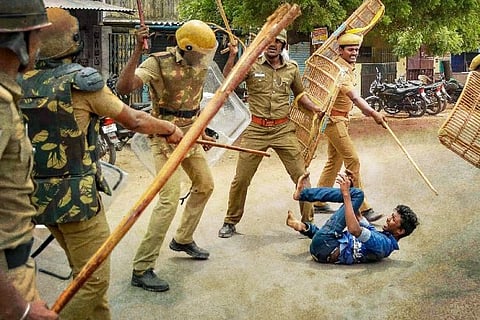

Chennai
This is particularly ironic because India doesn’t need to reference a case of police brutality from the US. The country has its own legacy of shame in this regard. According to data placed by the Home Ministry before the Rajya Sabha, the number of deaths of people in the custody of the Indian police is staggering. Till recently, the figure hovered at a rate of five custodial deaths per day.
But what many are unable to get over – particularly in the case of Jayaraj-Bennix - is the extreme brutality that the police is capable of displaying. What makes Indian police so savage almost, in their handling of those they have power over? One possible explanation could be the training. Right from their induction into the force, the police are told to toughen up, and are taught that instilling fear is part of the job. They are sometimes encouraged to use physical force, get abusive, as they deal with more hardened criminals and law-breakers on a daily basis, than most average people are exposed to in a lifetime. A policeman cannot hesitate or shy away from going headlong into a conflict situation when faced with riots, criminal attacks or even gunfire. But this still does not justify their indiscriminate use of force on people who are helpless, at their mercy, and completely unable to defend themselves.
If one were to look back at the history of police brutality, it’s an inheritance that dates back to colonial times. One of the most reprehensible cases of violence recorded in history took place on April 13, 1919 - the Jallianwala Bagh massacre - where the police killed at least 400 and injured over 1,500. And a century later, not much has changed. On April 16, 2020, at the start of the lockdown, 19-year-old Mohammed Rizwan was beaten to death by the police with rifle-butts and batons when he went outside to purchase a packet of biscuits in his village in UP. And no action was taken against the police responsible for Rizwan’s death. It should not come as a surprise that even the remedies for any police atrocity has a British legacy, as most state enactments are based on the Police Act of 1861, an archaic legislation under which disciplining the police was not a priority.
The increasing cases of police brutality particularly during the lockdown prompted the Commonwealth Human Rights Initiative to issue a set of guidelines for police in March this year. These guidelines, in no uncertain terms, prohibit police from using force on persons violating the lockdown regulations. However, it’s now clear that it will take much more than guidelines and rules for the police force to acknowledge its huge failing in its key role as guardian and protector.
There’s no room for whitewash, cover-ups or excuses. Those responsible must be held accountable, and punishment must fit the crime, after a fair investigation by an independent authority. Structured training in the use of weapons, human rights awareness, more stringent punishment for errant behaviour and close supervision by senior officers can go a long way in reducing, if not eradicating this dishonourable practice by policemen.
Visit news.dtnext.in to explore our interactive epaper!
Download the DT Next app for more exciting features!
Click here for iOS
Click here for Android